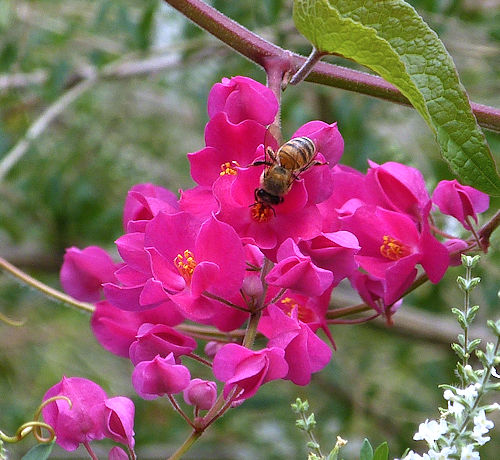Growing Antigonon leptopus:
Coral Vine
Description
Form: A climbing vine with coiling tendrils.
Lifespan: Perennial.
Leaf retention: Evergreen in frost-free areas.
Growth rate: Rapid.
Mature Size: To 40' (12m) long after many years in the ground.
Flowers: Small, pink, red, or rarely, white flowers without fragrance are clustered along often-branched flower stems. The "petals" are called tepals because sepals and petals are indistinguishable on this plant.
Bloom: Spring through fall. Blooming stops at the first frost in fall or the start of winter.
Fruit: Small brown seeds (achenes) within a capsule of dried tepals.
Leaves: Green, heart-shaped, ovate or triangular, medium-large.
Stems: Tendrils allow the vine to climb. The stems are initially herbaceous and become woody from the bottom up with age.
Roots: This vine forms underground tubers which grow larger with age. It can resprout from its tubers after freezing temperatures or after being cut to the ground.
Wildlife: The flowers attract bees. The seeds attract birds and small mammals.
Toxic / Danger: No.
Origin: Mexico and Central America.
Form: A climbing vine with coiling tendrils.
Lifespan: Perennial.
Leaf retention: Evergreen in frost-free areas.
Growth rate: Rapid.
Mature Size: To 40' (12m) long after many years in the ground.
Flowers: Small, pink, red, or rarely, white flowers without fragrance are clustered along often-branched flower stems. The "petals" are called tepals because sepals and petals are indistinguishable on this plant.
Bloom: Spring through fall. Blooming stops at the first frost in fall or the start of winter.
Fruit: Small brown seeds (achenes) within a capsule of dried tepals.
Leaves: Green, heart-shaped, ovate or triangular, medium-large.
Stems: Tendrils allow the vine to climb. The stems are initially herbaceous and become woody from the bottom up with age.
Roots: This vine forms underground tubers which grow larger with age. It can resprout from its tubers after freezing temperatures or after being cut to the ground.
Wildlife: The flowers attract bees. The seeds attract birds and small mammals.
Toxic / Danger: No.
Origin: Mexico and Central America.
Cultivation and Uses
USDA hardiness zones: 8-11. This plant dies to the ground in freezing temperatures.
Heat tolerant: Yes.
Drought tolerant: Yes.
Sun: Full sun to part shade.
Soil: This vine is tolerant of soil types but does better in enriched soil, pH 6.1-7.8 (slightly acidic to slightly alkaline).
Water once established: Once or twice a month in part shade, weekly in full sun during the hottest parts of the year.
Mulch: Add mulch in the fall to protect tubers in regions with hard winter freezes.
Prune: Winter cleanup of dead sections, possibly cutting the entire vine to the ground.
Litter: Low except winter cleanup.
Propagation: Seed, cuttings, layering, dividing tubers.
Uses: An attractive climbing vine for a wall, fence, or trellis; bee garden; culinary. As a ground cover it will climb over shrubs and small trees and may smother them.
The tubers are edible when cooked. The flour-coated leaves and flowers are fried and served with noodles. The flowers are cooked into omelets. The roasted seeds are winnowed and ground into a flour. The flowers and leaves are used to make a tea as a cold remedy.
USDA hardiness zones: 8-11. This plant dies to the ground in freezing temperatures.
Heat tolerant: Yes.
Drought tolerant: Yes.
Sun: Full sun to part shade.
Soil: This vine is tolerant of soil types but does better in enriched soil, pH 6.1-7.8 (slightly acidic to slightly alkaline).
Water once established: Once or twice a month in part shade, weekly in full sun during the hottest parts of the year.
Mulch: Add mulch in the fall to protect tubers in regions with hard winter freezes.
Prune: Winter cleanup of dead sections, possibly cutting the entire vine to the ground.
Litter: Low except winter cleanup.
Propagation: Seed, cuttings, layering, dividing tubers.
Uses: An attractive climbing vine for a wall, fence, or trellis; bee garden; culinary. As a ground cover it will climb over shrubs and small trees and may smother them.
The tubers are edible when cooked. The flour-coated leaves and flowers are fried and served with noodles. The flowers are cooked into omelets. The roasted seeds are winnowed and ground into a flour. The flowers and leaves are used to make a tea as a cold remedy.
Comments
This plant is a member of the Buckwheat family (Polygonaceae). Another common name is Queen Anne's Wreath. It is considered invasive in high rainfall areas but is well behaved in dry climates.
Do you have additional information or a different experience for these plants that you would like to share? Email info@GardenOracle.com. All contributions are welcome and appreciated.
This plant is a member of the Buckwheat family (Polygonaceae). Another common name is Queen Anne's Wreath. It is considered invasive in high rainfall areas but is well behaved in dry climates.
Do you have additional information or a different experience for these plants that you would like to share? Email info@GardenOracle.com. All contributions are welcome and appreciated.



Latest update: October, 2024
© 2008-2025 by GardenOracle.com

